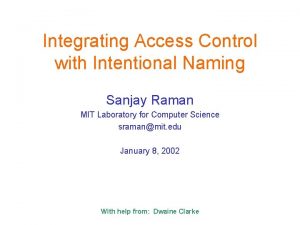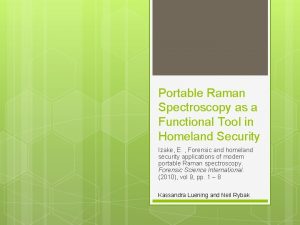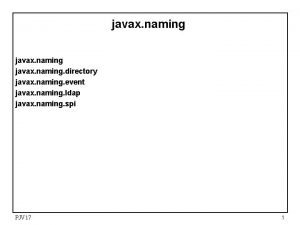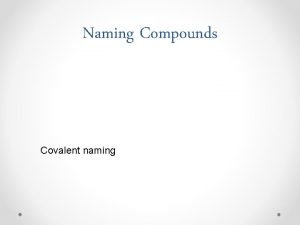Integrating Access Control with Intentional Naming Sanjay Raman








![The Naïve Solution Intentional Naming Service NAME-TREE root [service = printer [load = 2]] The Naïve Solution Intentional Naming Service NAME-TREE root [service = printer [load = 2]]](https://slidetodoc.com/presentation_image_h2/c92135963f75a40f06aae0d441c1ea66/image-9.jpg)









- Slides: 18

Integrating Access Control with Intentional Naming Sanjay Raman MIT Laboratory for Computer Science sraman@mit. edu January 8, 2002 With help from: Dwaine Clarke

Main Goal • Create an infrastructure to provide secure, access-controlled resource discovery in dynamic networks using intentional naming

Overview • Problem Description • Intentional Naming Introduction – Security extensions • • Integration of Access Control Security Advantages Status Questions

Motivation • Consider a dynamic environment with many users and resources • Resources should be given the ability to restrict specific users / applications • Automatic discovery of accessible resources

Usage Scenario ACL Director … Director K 2 Student K 1 Student K 2 Student ACL Director K 1 Students K 1 Student … ACL Director K 1 Students K 2 Students …

Access Control • • Useful mechanism in guarding access to resources Security Model Suitable for dynamic environments Each resource maintains a list of referencing a set of valid keys – Granting, delegating, revoking authorizations – user/application does not know accessibility of resource without explicitly attempting access User

Intentional Naming • Resource discovery and service location system for dynamic networks • Uses a simple language based on attributes and values to identify resources • Language used to describe the desired resource – Applications describe what they are looking for, not where to find it INS [building = lcs [floor = 2 [service = printer [load = 4]]] DNS pulp. lcs. mit. edu

Security Extensions of INS • INS is a naming service; designed to be a layer below security – No built-in mechanism to implement access control – Cannot explicitly reject requests from unauthorized users • Extend INS to provide access control decisions • Application should find best resource to which it has access – Increases scalability and performance – Costly to perform full authentication and authorizations checks
![The Naïve Solution Intentional Naming Service NAMETREE root service printer load 2 The Naïve Solution Intentional Naming Service NAME-TREE root [service = printer [load = 2]]](https://slidetodoc.com/presentation_image_h2/c92135963f75a40f06aae0d441c1ea66/image-9.jpg)
The Naïve Solution Intentional Naming Service NAME-TREE root [service = printer [load = 2]] service User B K 21 Proxy location printer 1. lcs. mit. edu printer 2. lcs. mit. edu printer 3. lcs. mit. edu <ok> authentication [user B] printer 1 printer 2 printer 3 Printer 1 Proxy Printer 2 Proxy Printer 3 Proxy User A User C User D User A User B <print> mit ai-lab lcs

A Scalable Solution Cricket Listener Wireless Comm. K 21 Proxy {request} {print to closest, least-loaded printer} Intentional Name Routers Proxy-to-proxy security Printer Proxy pulp. lcs. mit. edu

Integration of Access Control KEY IDEAS • Store ACL as attribute-value pair on each resource proxy • INS routers maintain dynamic name-trees – Propagate ACLs up the tree when they are modified – “OR” ( ) ACLs at each parent node • Access Control decisions made during traversal – Name-Lookup algorithms will eliminate resources based on membership in intermediate ACLs

Integration of Access Control Constructed ACL 1 ACL 2 ACL 3 NAME-TREE root service ACL 1 ACL 2 ACL 3 location Periodic Updates printer camera speakers ACL 1 ACL 2 ACL 3 mit ai-lab lcs Resource-level ACLs name-record Name record resolution

Integration of Access Control • Proxy performs transitive closure of its certificates and sends appropriate rules to INS with request • INS processes request by pruning name-tree and making access decisions • INS returns best accessible address • Proxies perform Proxy-to-Proxy protocol with full authentication

System Architecture Revisited Cricket Listener Wireless Comm. K 21 Proxy K 21 {request} {print to closest, least-loaded printer} Intentional Name Routers K 21’s Certificates Proxy-to-proxy security Printer Proxy K 1 students K 2 students Kc Transitive Closure of K 21’s Certificates K 1 students K 2 students (*) K 2 students Kc (*) K 1 students Kc 192. 168. 0. 45

Proxy-to-Proxy Security • SPKI/SDSI Model • Protocol does not have to be repeated in order to determine access privileges – INS will return the address of a resource you are guaranteed access to – ACL check should succeed the first time • Enhances scalability of automation system – Previous model would be unusable

Proxy-to-Router Updates • Access revocation and delegation • Resource status updates – Periodic Event – Flooding concerns • One-way messages must be secure and authentic – Do. S attacks {revoke user B} Resource Proxy Triggered Update Periodic Update {increase in load} Revocation of User B user A user B user C INS Router

Status • Implementation of system is underway • Performance evaluation – Tradeoff: overhead in creating “OR”ed versus ACL checks – State inconsistency in boundary cases • Goal: integrate with existing automation system – Scale system to a large number of nodes

Questions?
 Sanjay raman mit
Sanjay raman mit Terminal access controller access control system
Terminal access controller access control system Terminal access controller access-control system
Terminal access controller access-control system In one sense water is the commonest of liquids
In one sense water is the commonest of liquids Raman letchumanan
Raman letchumanan Aina mbili za ramani
Aina mbili za ramani Armida sodo
Armida sodo Applications of raman effect in daily life
Applications of raman effect in daily life Fizik raman
Fizik raman What is the difference between ftir and raman spectroscopy
What is the difference between ftir and raman spectroscopy Difference between ir and raman spectroscopy
Difference between ir and raman spectroscopy Portable raman analyzer for hazmat and narcotics
Portable raman analyzer for hazmat and narcotics Low na
Low na Espectroscopia raman instrumentacion
Espectroscopia raman instrumentacion Raman wants to send a few photographs
Raman wants to send a few photographs Rayleigh vs raman scattering
Rayleigh vs raman scattering Raman spectroscopy selection rules
Raman spectroscopy selection rules Raman effect wikipedia
Raman effect wikipedia Raman scattering definition
Raman scattering definition



































